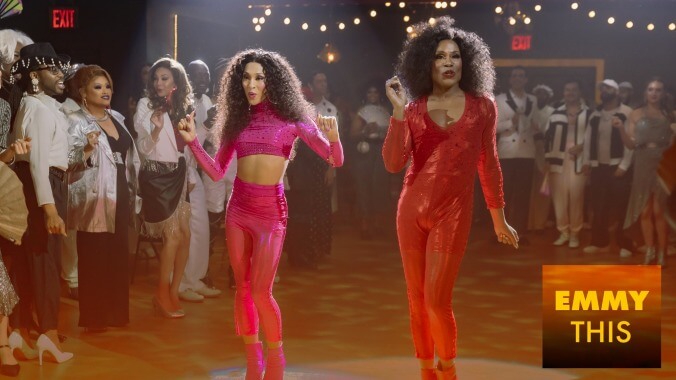The show’ glamorous sequences border on fantasy, but they capture the boundless creativity of the ballroom community throughout the decades, and are brought to life by cast members like Rodriguez, Moore, Jackson, Porter, Hailie Sahar, and Angelica Ross. Pose costume designer Analucia McGorty, makeup department head Sherri Berman Laurence, and hair lead Barry Lee Moe also play key roles in crafting these head-turning moments; they were each Emmy-nominated for their work in 2019 and 2020. With the level of effusive spectacle in the recently concluded third season, Emmy voters should recognize the craft teams once more. (They should also finally put Rodriguez in the Outstanding Lead Actress in a Drama race, where she belongs).
Moe’s work this season has taken as much inspiration from ball culture and the wider world of pop culture as character evolution. Pose leapt forward in time on multiple occasions, its three-season story covering a 10-year period. Blanca adopted many different looks during that time, as she went from House member to House mother to registered nurse, but Moe—who won the Emmy for Outstanding Period And/Or Character Hairstyling for a different Murphy production, Hollywood—took care to preserve her signature finger-waved edges. According to Moe, Blanca’s look in season three, with bouncy tresses and slicked-down crown, was modeled after Intimacy singer Jody Whatley. Lisa Bonet inspired Angel’s curls, while Toni Braxton was on the mood board for both Lulu and Blanca. And, as we’ve seen in multiple performances during “Candy’s Sweet Refrain,” Pray’s drag look takes after none other than Diana Ross.
Specificity is also at the root of Pose’s awe-inspiring coiffures: Moe made sure that his team, including Timothy Harvey, Tene Wilder, and Greg Bazemore, was primarily composed of Black hairstylists. The lead hair designer also pored over ’90s issues of JET and Ebony as well as vintage ballroom photos, revealing to People that Elektra’s feathered look in “Intervention” was an homage to ballroom icons Octavia St. Laurent and Danielle Revlon. Throughout the show’s run, the House mother turned mogul’s main style was a gorgeous bob which could be at once sculptural and free-flowing. For this fanciful look, Moe’s team had to use a braiding technique and one of the 100 standby wigs (in addition to the 20 cast wigs) used in season three.
The Pose hair team raised the bar for themselves in “Something Old, Something New,” crafting unique looks for the bevy of brides at Angel’s wedding—the result of Elektra playing fairy godmother for the many ballroom regulars. Angel’s cascade of curls had a more timeless look, while Elektra continued to serve Dynasty royalty and Blanca’s waves were pulled and pinned to the side to accentuate her tactile, one-shouldered dress (made by Pray Tell, no less).
In any given episode, there are show-stopping moments, sartorial and otherwise. But “The Trunk” might be the hair team’s crowning glory. The flashback-filled episode puts the spotlight on Elektra, and how she came to be mother of the House Of Abundance. Mistreated and misunderstood by her own mother, Elektra looked after other trans women like Blanca, Lulu, Candy, and Angel, as well as young queer men like Lemar (Jason Rodriguez) and Cubby (Jeremy McClain). After confronting her mother Tasha (Noma Dumezweni) one last time, Elektra recovers a trunk filled with her most prized possessions, which she readily trades for the money that will help her look after her children. The House Of Abundance then makes its debut, spinning a dismaying reality into several fairy tales on the runway—among them, Blanca as Snow White, Angel as Red Riding Hood by way of Red Sonja, Lulu as Rapunzel, Elektra as the Evil Queen, Candy as Sleeping Beauty. Moe and his team pay tribute to fierce women, Blanca’s pixie cut recalling Toni Braxton’s while Angel’s curly ’do gives off Brigitte Nielsen vibes. Lulu’s and Candy’s looks are even more intricate: Sahar had to have the 50-foot, 20-pound braid “bolted” to her wig, while Ross’ look incorporated multiple wigs and a pillow.
The results are, as ever, effortless—as if Elektra merely waved a magic wand and transformed her children into the runway-dominating forces they’d become. But as the once-domineering mother notes in the series finale, the ballroom competitions were never just make-believe: They were practice for all they’d achieve in real life. The Pose hair team has had plenty of practice, and recognition, but it’s time for Emmy voters to make their dreams a reality.














![HBO teases new Euphoria, Larry David, and much more in 2026 sizzle reel [Updated]](https://img.pastemagazine.com/wp-content/avuploads/2025/12/12100344/MixCollage-12-Dec-2025-09-56-AM-9137.jpg)



























